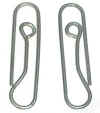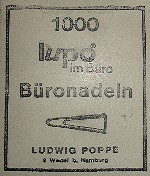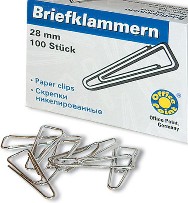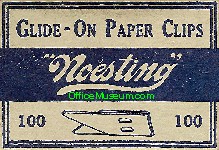|
| Paper Clips |
Early Office Museum
History of the Paper Clip

Advertisement for the Common-Sense Paper Clip
What counts as a paper clip? For purposes of the discussion and timeline presented here, a paper clip is a flat or nearly flat piece of metal that slides over an edge of a set of papers and holds the papers together without being bent or pinched by the user and without piercing the papers. A large majority of different paper clip models were made by bending single pieces of resilient spring steel wire. Three others were stamped from sheet metal (Eureka, Sheet Brass Gothic, Proco) and another four (Angell, Utility, Vise, Acme Correspondence) were made by folding small pieces of resilient sheet steel. One (Nifty) was made by bending a wire into a spiral and then flattening it. Recently some paper clips have been made of plastic, but these are not covered here.
During the 19th and early 20th centuries, the term "paper clip" was also used to refer to a spring loaded clip that was generally two or more inches long. This type of clip was also called a "letter clip." We consider these devices on our web page dealing with small filing devices.When were paper clips introduced? The first paper clip was patented by Samuel B. Fay in 1867. This clip was originally intended primarily for attaching tickets to fabric, but the patent recognized that it could be used to attach papers together. We have found no advertisement for, or other mention of, the Fay design until 1896. In 1896, the American Stationer announced that D. S. Gorman was the New York, NY, distributor for a "new paperclip," named "Clinch;" this clip used the Fay design. Also in 1896, the Cinch Clip Co., Buffalo, NY, was identified as the manufacturer of a paper clip named "Cinch," which also used the Fay design. It therefore appears unlikely that paper clips with the Fay design had significant, if any, sales prior to 1896. However, beginning in the late 1890s and for decades thereafter, the Fay design was widely advertised under many brand names for use in fastening papers. In 1918, the brand name "Fay" was used by the American Clip. Co. for a paper clip with the Fay patent design. A second paper clip design was patented by Erlman J. Wright in 1877. This clip was advertised at that time for use in fastening newspapers. A third paper clip was patented by Frank Angell in 1889.
The Gem paper clip, which was never patented, but which became by far the best selling paper clip in the U.S., was introduced in 1892 and has been advertised since 1893. In 1904, when Cushman & Denison applied for a trade mark for the Gem clip, the company stated that it had used the Gem brand name for clips since 1892. And in a 1922 advertisement for the Gem paper clip, Cushman & Denison stated, "Thirty years ago we placed on the market the first 'Gem' Clip."
Cushman & Denison Advertisement for Gem Paper Clips, 1922
Speculation that the Gem paper clip originated in Britain by the early 1880s is incorrect. This speculation is based at least in part on references to "Gem Paper Fasteners" in publications dating from 1883 and 1884; these publications did not contain either illustrations or verbal descriptions of these fasteners. However, the Early Office Museum has found an 1881 publication with an illustration that shows that Tower's Gem Paper Fasteners were staples with legs that were bent toward each other after they were manually inserted through slits cut in papers. They were not paper clips.

Advertisement for Gem Paper Fasteners, Britain, 1881
When did paper clips come into widespread use in offices? A patent application filed at the end of 1896 indicated that a number of different paper clips were in use. A flood of paper clip patents were issued beginning in 1897. A 1900 trade publication stated that "The wire clip for holding office papers together has entirely superseded the use of the pin in all up-to-date offices." (Business, March 1900, p. 173) This evidence indicates that paper clips came into widespread use in U.S. offices in the late 1890s.
Why weren't bent-wire paper clips marketed earlier? According to Petroski, "Steel wire was still new in the second half of the nineteenth century....[T]he widespread manufacture and use of the paper clip had to await not only the availability of the right wire but also the existence of machinery capable of tirelessly and reliably bending it in a flash into things that could be bought for pennies a box." (Henry Petroski, "From Pins to Paper Clips," The Evolution of Useful Things, Vintage, New York, 1992, p. 60)
With what products did paper clips compete most closely? The two earliest patents indicate that bent-wire paper clips could be used in lieu of pins, sewing, "pointed bent-over paper fasteners," and eyelets. In 1904, Clinch Clips were advertised as "Cheaper than Pins." Around 1910 advertisements compare paper clips to straight pins for temporary attachment of papers. By contrast, early paper clip advertisements do not refer to staples.

T Pin Box, Cushman & Denison, patented 1902 & 1904
Why were paper clips sold in so many different designs? Many designs were initially protected by patents. As a result, other manufacturers had to come up with different designs. Also, no single paper clip design is optimal for all purposes. In marketing paper clips, suppliers emphasized the superiority of their designs on one or two of the following characteristics:
1. Does not catch, mutilate, or tear papers
2. Does not get tangled with other clips in the box
3. Holds a thick set of papers
4. Grips firmly, holds papers securely
5. Is flat or thin and takes less space in files
6. Is easily inserted
7. Is light weight and requires less postage
8. Is non-deforming
9. Is cheap (e.g., because it uses less wire)
What is included in the paper clip time-line below? The Early Paper Clip Gallery below identifies every paper clip that we are aware of that has a patent date before the end of 1902 plus every one for which we have found an advertisement, box, or example (but excluding modern plastic and decorative paper clips, e.g., ones in the shape of a bone or star). Many additional designs that are not shown here were patented. Presumably most of these were not advertised widely or for long, if at all. In the case of paper clips patented before the end of 1902, if we do not have an advertisement or box that tells us the brand name of the clip, we have identified the clip using the patent holder's last name in italics.
We did not include paper clips that were patented after 1902 unless we could find evidence that they were produced. We used that cutoff date because 13 paper clip patents were awarded in 1903, 10 of them to one inventor, George W. McGill. Of the latter 10, only three appear to have been produced (Banjo, Ring, Improved Gem).
Where did the Early Office Museum obtain the information on this web page? The information on this page is based on our review of patents, early trade publications, artifacts, and other primary sources. As a result, unlike much of the information on the history of the paper clip that is available on the internet, the information presented here is accurate. The Early Office Museum is grateful to Kenneth R. Berry for sharing his patent and trademark research on paper clips.
Would you like to swap, sell, donate, or purchase early paper clips? If the Early Office Museum has an example of a particular paper clip, we put an "X" at the end of the text in the box in the right-hand column in the pertinent row of the table below. We have duplicates of most of those, but not all. We would be happy to swap our duplicate early paper clips for ones we do not have. We will also sell duplicates, and we will purchase or accept donations of ones we do not have. We are also interested in photos/scans of paper clips, boxes, and advertisements (if possible dated) that we do not have to post on the Museum web site with a credit to you. Please email the Curator: eomcurator, followed by @, followed by hotmail.com with the subject line "paper clips".
Early Paper Clip Gallery
| Image | Brand Name Other Brand Names Dates The date in Bold font was used for the chronological order. |
Additional Information An X at the end of this box indicates that the Museum has an example of this clip. |
 |
Fay Paper Clip Amneco (1917-21), C (1910, 1918), Chicago, Cinch (1896), Climax (198[fix]-22), Clinch (1896, 1918), Cyclone (1920), Fay (1918), Jiffy, New York, Philadelphia, Queen City, Simplex (1918), Uneedit (1928), West Patented 1867 Advertised 1896 (as Clinch)-1961 |
 The patent awarded to Samuel B. Fay described this clip as a ticket fastener to be used, in lieu of a pin, to fasten tickets to fine fabrics. The patent noted that the clip could be used to attach a paper ticket to another piece of paper. The patent awarded to Samuel B. Fay described this clip as a ticket fastener to be used, in lieu of a pin, to fasten tickets to fine fabrics. The patent noted that the clip could be used to attach a paper ticket to another piece of paper.X |
| Wright Paper Clip Patented 1877 Advertised c. 1877 |
The patent awarded to Erlman J. Wright stated that the clip was designed for "fastening together loose leaves of papers, documents, periodicals, newspapers," in lieu of sewing, "pointed bent-over paper fasteners," or eyelets. The clip was advertised as a newspaper clip. | |
 |
Angell Paper Clip Patented 1889 |
The patent for this clip is titled "Book-Leaf or Paper Holder." However, the patent description states that one of its uses is to "hold together two or more pieces of paper--as, for instance, a letter and check received together." The patent states that this item consists of "a piece of flat metal bent or folded to form two lips of unequal length, the shorter lip curved upward and the longer lip flat." The scan to the left shows the shorter, curved lip (the right side of which bulges toward you as you view the scan) in front of the longer, flat lip. X |
 |
Utility Paper Clip Patented 1895 Advertised 1890-1900 |
Made from sheet metal by O. W. Smith Manufacturing Co. Detroit, MI. and subsequently Stationers' Mfg. Co. Detroit, MI. Also distributed by Library Bureau, Boston, MA X |
| Gem Paper Clip Glide, Superior (1920), Lightning (UK), Facile (UK), Fixum (Germany), Kimhar Not patented Advertised 1893-Present In 1904, Cushman & Denison obtained a trademark for "Gem" used in connection with paper clips. The announcement of the trademark stated "Used since March 1, 1892," so it is probable that the Gem Paper Clip was introduced on that date. |
August 1894 ad. All rights reserved. The earliest known Gem paper clip advertisement, which was discovered by the Early Office Museum, is in the September 1893 issue of The American Lawyer. The seller was Cushman & Denison. X | |
| Patent Spring Clasps Advertised 1893-1900 |
Distributed by the Library Bureau,
Boston, MA, which claimed that these spring clasps "largely supersede pins, staples, paper fasteners, rubber bands, clips, and all devices for fastening papers or cards together." Image from online article by Alan Walker, Processing Archivist, National Archives, College Park, MD. X | |
 |
Eureka Clip Farmer Patented 1894 Advertised 1897-30 (The brand name Farmer comes from the name of the inventor, George P. Farmer) |
 Made from sheet metal, not bent wire, by Consolidated Safety Pin Co., Bloomfield, NJ. X |
 |
Niagara Paper Clip Patented 1897 Advertised 1897-1950 |
Niagara Clip Co., New York, NY Standard clip is small. Larger version sold as Giant Niagara Clip.  Add image from 1904 System X |
 |
Simplex Clip Patented by Reeve Apr. 20, 1897 Advertised 1897 |
"Holds securely from one to twenty thicknesses." Simplex Specialty Co., Ltd. Philadelphia, PA |
 |
Cole Paper Clip Patented 1897 |
The patent indicates that a number of bent-wire paper clips were already in use when the application was filed in December 1896. "Previous to my invention various forms of bent-wire clips have been used. Some of them do not grip the articles with sufficient force, while others endanger a tearing. Others are difficult or inconvenient, and others still are clumsy or have some portion projecting transversely to the plane of the papers." |
 |
Perfection Paper Fastener Patented 1898 Advertised 1898-1900, 1916-20 |
Made by M. P. & J. R. Schooley, Homestead, Pa. |
 |
Schooley Paper Fastener Patented 1898 | . |
| Columbia Paper Clip Scientific Advertised 1899 |
Columbia Manufacturing Co. Buffalo, NY Successor to the Scientific Clip Co. | |
 |
Clipper Paper Clip Duplex Patented 1899 Advertised 1900-11, 1921-23 |
Clipper Mfg. Co., Long Island, NY In 1903, the Clipper paper clip was available in brass or steel.  X |
 |
Daisy Paper Clip Patented 1899 Advertised 1908 |
. |
 |
Vaaler Paper Clip Patented 1900 (Germany), 1901 (US) |
Image is one of several in the 1901 US patent. Vaaler, who was Norwegian, is commonly but incorrectly given credit for invention of the paper clip. His designs were neither first nor important. There is a large Gem paper clip statue in Norway. Norway might consider giving it to the U.S. |
 |
Konaclip Paper Clip L.B. Expansive Patented 1900 Advertised 1904-10, 1917 (L.B. Expansive) |
 X X |
 |
McGill Paper Clip Patented 1900 |
. |
 |
Octo Fastener Advertised 1901-10, 1917-18 |
Attleboro Stock Co., New York, NY (1903-04) American Clip Co., Long Island City, NY "A pin, paper clip and paper fastener in one."  1903 ad X |
 |
Wright Paper Clip Patented 1901 |
. |
 |
De Long Paper Clip Patented 1901 |
The inventor of this paper clip, Frank E DeLong, and his brother owned the DeLong Hook & Eye Co., Phildelphia, PA. The company's main line of business was hooks and eyes for the garment industry. During 1912-21, this company sold the Twin Grip paper fastener based on a 1908 patent. |
 |
Mowen Paper Clip Patented 1901 |
. |
 |
Ideal Paper Clip (very small) or Clamp (larger) Triumph Patented 1902 Advertised 1903-Present |
Cushman & Denison Mfg. Co., New York, NY ACCO Brands, part no. ACC-72130, as of 2013. X |
 |
Multiple Grip Paper Clip Style E Advertised 1902 |
Meyercord-Batterman Co. Chicago, IL "An inexpensive clip that grips flat in four places. Does not slide under papers" |
 |
Mussinan Paper Clip Patented 1902 |
. |
 |
Cox Paper Clip Patented 1902 |
. |
 |
Whitcomb Clip Ringklip Advertised 1902-04 (Whitcomb, US), 1910 (Ringklip, Europe) No longer produced 1910 (Whitcomb, US) |
 The Wire Novelty Co., Holyoke, MA (1902-04) X |
 |
Banjo Paper Clip Improved Gem No. 2, Banjo Gem Patented 1903 by George W McGill Advertised 1909-41 |
Cushman & Denison Mfg. Co. X |
 |
Ring Paper Clip Rinklip, Circle Patented 1903 by George W McGill Advertised 1905-Present |

 A.A. Weeks Mfg. Co., New York, NY (Ring, 1905) Cushman & Denison Mfg. Co (Ring). The Rinklip advertised in 1905 had a flat top. X |
 |
Improved Gem Paper Clip Improved Gem No. 1, Lipgrip (UK), Facile with Lip (UK) Glid-don (Australia), Clipper (UK) Patented 1903 by George W McGill Advertised 1909-24 |
Cushman & Denison Mfg. Co. X |
 |
Weis Paper Clip Eureka, Star, Triangle Patented 1904 Advertised 1903-41 |
Weis Binder Co. (1905) During 1904, the US Patent Office issued three patents for paper clips with essentially this same design. X |
 |
Common Sense Paper Clip Patented 1904 Advertised 1904-25 |
Jackson Mfg. Co., Jackson, MI. Book-Keeper Publishing Co., Ltd., Detroit, MI (1905) X |
 |
Owl Paper Clip Regal, Peerless, Supreme Advertised 1905-Present |
 Owl Supply Co., Boston, MA ACCO Brands, part no. ACC-72130, as of 2013. X |
 |
Weis Herculean Reversible Paper Clip Marketed 1905 ~ Advertised 1907-10, on market 1918 |
Weis Binder Co., Toledo, OH (1905) Weis Mfg. Co. |
 |
Mogul Paper Clip Patented 1906 Advertised c.1906, 1908-10, on market 1918 |
Clipper Mfg. Co. As of 2016, being reproduced with thin brass wire. |
 |
Improved Niagara Paper Clip Same 1897 patent as the Niagara Paper Clip above Advertised 1908-1950
|
Niagara Clip Co., New York, NY X |
 |
Hold-Fast Paper Clip Holdfast Advertised 1909-10, on market 1918 |
Cutler-Tower Co., Boston, MA |
 |
Elastik Klip Advertised 1910 |
Tower Mfg. Co. catalog, 1910. Described as a "corner clip" (American Stationer, Jan. 1, 1910) |
 |
Dennison Paper Clip Advertised 1910, 1918 (on market), 1921 (clearance sale) Illustrated in Webster's New International Dictionary 1934. |
Dennison Mfg. Co. X |
 |
Standard Paper Clip Advertised 1910-41 |
Cushman & Denison Mfg. Co. X |
 |
Wing Paper Clip Advertised 1915, on market 1918 Courtesy of Cornelia Moyer |
 Wing Paper Clip Co., Philadephia, PA X |
 |
Improved Triangle Patented 1917 Advertised 1923-25  |
X |
 |
Little Gem Paper Clip On market 1918 Lupo paper clip (Germany) 
|

Little Gem paper clip with lip, Germany, marketed 2013 X |
 |
Vise Paper Clip Patented Advertised 1918-50 (Graffco), 1928 (Cook's Burro), 1974 (Burro) |
Vise Clip Co., Boston, MA Graffco Vise Clip Co., Boston, MA (1918-50)  X |
 |
Ezeon Paper Clip Handi-Grip, Imperial, Rapid, Universal, Victory Patented 1920 Advertised 1918-89 |
 X |
 |
Victory Paper Clip Patented 1920 Advertised 1921-22 |
J.F Ryan & Co., New York, NY |
 |
Collette Paper Clip Frictioned Patented: Collette 1921 Including all brands, advertised 1924-40 This type of clip had many equi-spaced perpendicular serrations on the long sides only, not on the ends. Serrations are designed to hold papers securely. |
Collette Mfg. Co., Amsterdam, NY X |
 |
Marcel Gem Paper Clip Saspraude (Latvia), Savarzeles (Lithuania) Patented 1924 Marketed 1931-93 (confirm. 1955-61 confirmed) This type of clip had fewer indentations than the Collette-type clips |
Noesting Pin Ticket Co., New York, NY |
 |
Non-Skid Gem Paper Clip Dandy Gem, Gripit, Standard Gem Patented: Non-Skid 1927, Dandy 1927, Gripit 1930 Trademark: Dandy (Noesting) 1923 (renewed 1943) Advertised 1936-61, 1974 (Standard Gem), present This type of clip had many equi-spaced perpendicular serrations all along the wire, not just on the long sides. Serrations are designed to hold papers securely. |
X |  |
Perfected Gem Paper Clip Perfect, Perfect Gem, Gothic, Gothic Gem, Spear, Clipper (England), Trikla (Germany) Patented 1934 Advertised 1937-Present Widely used on European continent |
.  X |
 |
Nifty Paper Clip Kurly Klip, Spiral, Clipiola Patented 1936 (Nifty), 1939 (Kodye Kurly Klip) (Similar design patented 1907) Advertised 1937-Present The shapes of the spirals vary among brands. |
  . .Left: Kodye Kurly Klips. Right: Clipiola. X |
 |
Acme Correspondence Clip Glide-On Paper Clip Acme: Advertised 1950 Glide-On: Apparently marketed 1993-94 Glide-On: Production ended in 1994-95 Acme did not have the small indentations that the Glide-On (see images) has. |
 X X |
 |
Rapid Gem Paper Clip |
 Made in USA X |
| Vee-Clip Marketed by 1966 (pre-ZIP code) |
Majestic Staple Co., Brooklyn 6, NY | |
 |
Radia Paper Clip (France) Sava (France), Polar (Germany), Ckpenky (Latvia) |
. |
 |
Unidentified Paper Clip A | Similar to diagram in US Patent No. 2,324,929 issued to Willis A. Jennings, 1943 |
 |
Unidentified Paper Clip B | . |
 |
Unidentified Paper Clip C |  Paper clip, Serbia, 2008 |
 |
Unidentified Paper Clip D | We infer this is likely to be a paper clip because on two separate occasions we found one in a mixed batch of antique/vintage paper clips. X |
 |
Unidentified Paper Clip E | We infer this may be a paper clip because we found one in a mixed batch of antique/vintage paper clips. X |
 |
Unidentified Paper Clip F | We infer this may be a paper clip because we found one in a mixed batch of antique/vintage paper clips. X |
 |
Sheet Brass Gothic Paper Clip Germany | . |
 |
Proco Paper Clip Europe Courtesy of H A M Stumpel |
 X |
 |
Sheet Metal Advertising Paper Clips Netherlands We have misplaced the name of the person in the Netherlands who donated these. |
 X |
 |
Sheet Metal Advertising Paper Clip Netherlands |
X |
Additional paper clips are listed by name but not illustrated in Who Makes It and Where: The Stationers' Book of Knowledge, 1918-19, Andrew Geyer, Inc., New York, copyright 1916. Also, "You are Cordially Invited to a Preview of the Emanuel Fritz Paper Clip Collection at the Smithsonian Institution, Washington, D.C.," American Collector, July 1973, contains photographs of portions of several paper clips that are not included above. Because the complete clips are not visible, we are unable to match them to patent diagrams.
A Nifty Story About Paper Clips

 Matt Boytim writes: "My buddy and I were students in the early 80's. We commuted to school and parked in a lot with meters. Being poor college students we were interested in feeding the meters with something other than money, and we had heard that you could use 'paper clips'. Of course, this made no sense to us until my buddy bought a box of Nifty Clips. We put a Nifty Clip in the dime slot of the meter, and a penny in the nickel slot, and wind the meter up to 4 hours. This worked because the nifty clip was slightly bigger in diameter than a dime and acted as a spring. It would compress to fit through the dime slot and once through would expand to engage the timer when you turned the knob. The penny was needed, I guess, because something solid had to be in one of the coin slots. We went to get more clips from an office supply store. When we paid, the guy said, 'So these things still work in the parking meters.' We did this for about two years, until they raised the price of parking and removed the dime and nickel slot. If you really care I can tell you what we did after that, but it had nothing to do with Nifty Clips."
Matt Boytim writes: "My buddy and I were students in the early 80's. We commuted to school and parked in a lot with meters. Being poor college students we were interested in feeding the meters with something other than money, and we had heard that you could use 'paper clips'. Of course, this made no sense to us until my buddy bought a box of Nifty Clips. We put a Nifty Clip in the dime slot of the meter, and a penny in the nickel slot, and wind the meter up to 4 hours. This worked because the nifty clip was slightly bigger in diameter than a dime and acted as a spring. It would compress to fit through the dime slot and once through would expand to engage the timer when you turned the knob. The penny was needed, I guess, because something solid had to be in one of the coin slots. We went to get more clips from an office supply store. When we paid, the guy said, 'So these things still work in the parking meters.' We did this for about two years, until they raised the price of parking and removed the dime and nickel slot. If you really care I can tell you what we did after that, but it had nothing to do with Nifty Clips."

